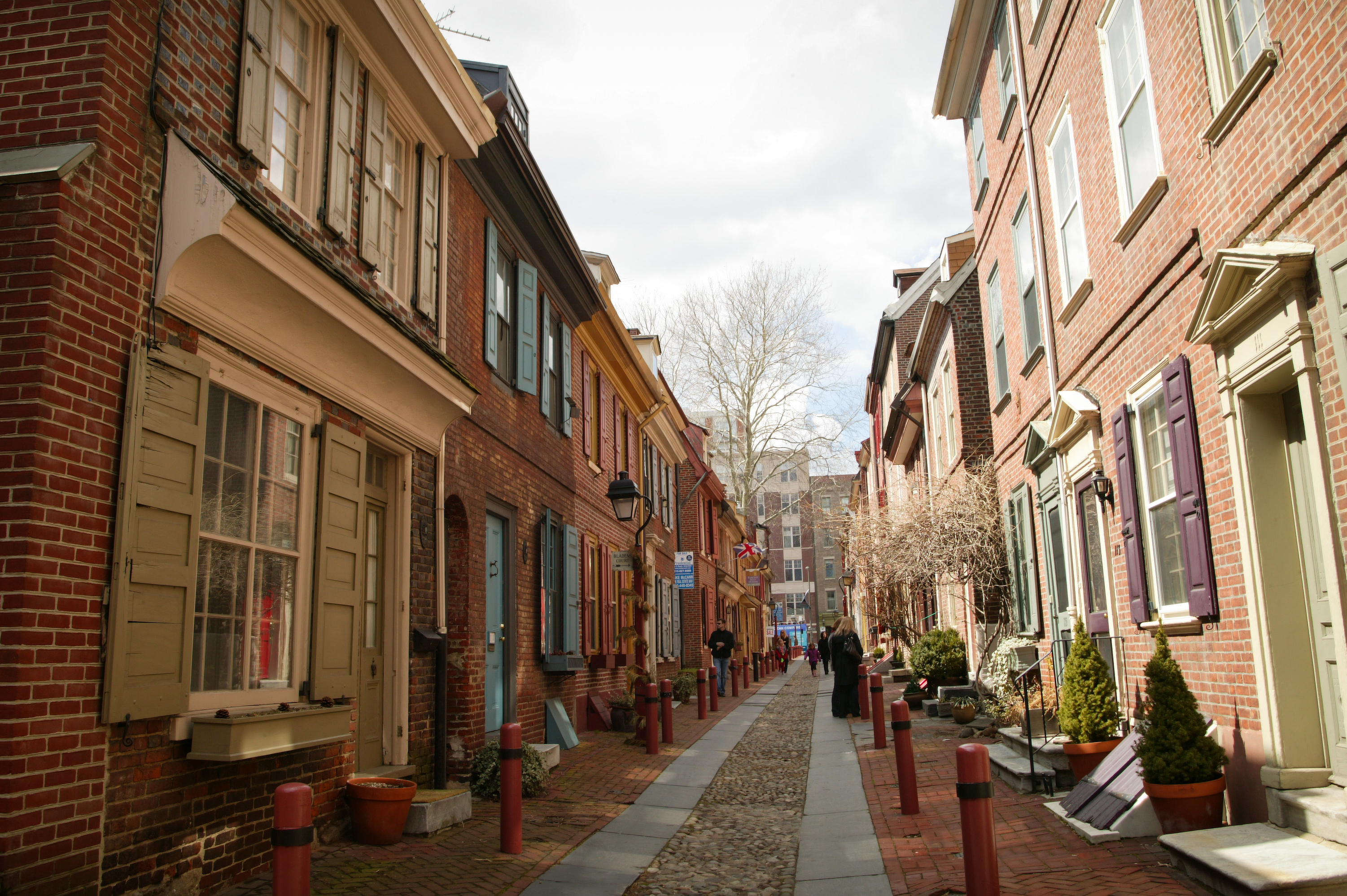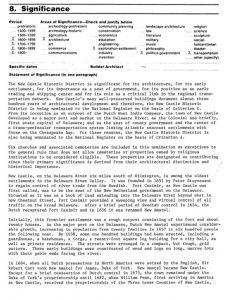Historic Districts
Essay
Throughout the Philadelphia area, in communities large and small, concentrations of buildings, landscapes, and natural features that collectively reflect the region’s cultural and historical development have been documented and recognized as historic districts. Often described as areas where the “whole is greater than the sum of its parts,” historic districts have been at the core of modern historic preservation planning and policy in the United States since the mid-twentieth century. While the specific meaning of designation as a historic district depends on what body made the designation, these areas have encompassed thousands of homes, commercial and institutional buildings, and landscapes relating to significant periods or themes in economic, social, and architectural history.

Historic districts emerged in the United States in the 1930s when Charleston, South Carolina, and New Orleans, Louisiana, passed local ordinances designating large areas of those cities as places of historical and architectural significance. On the federal level, historic districts first gained recognition under the National Historic Landmarks (NHL) program, authorized by the Historic Sites Act of 1935. Beginning in the early 1960s, a number of districts in the Philadelphia region received NHL status, including Elfreth’s Alley (1960), Brandywine Battlefield (1960), Colonial Germantown (1965), Washington’s Crossing (1961), Princeton Battlefield (1960), and the New Castle Historic District (1967). Some of these districts were initiated by historians at the National Park Service, while others were the result of community organizations seeking recognition for places that were at risk from disinvestment and increasing suburban development. These districts also earned listing in the National Register of Historic Places when it was created in 1966, because the Register included districts as one of the eligible property types. Over time the National Park Service developed guidelines for how to recognize, define, and document historic districts, and eventually dozens of districts in Pennsylvania, New Jersey, and Delaware encompassing several thousand buildings and significant cultural landscapes joined the National Register.
Listing in the National Register or as an NHL served to raise awareness and generate pride in the history of these communities at a time when the United States was changing rapidly. National Register listing did not restrict private property owners from altering or demolishing properties in the districts, but did help to protect places such as Elfreth’s Alley from destruction related to construction of I-95. Over time, some of the Philadelphia’s most significant and iconic neighborhoods including Society Hill and Old City, Chestnut Hill, and Spruce Hill, became National Register Historic Districts as a result of efforts by community organizations. Many National Register districts in the city, especially in Center City and West Philadelphia, were initiated by the city and developers in an effort to make rehabilitation projects for historic buildings eligible for federal historic preservation tax credits. Beyond the city’s oldest and grandest residential neighborhoods, commercial areas such the South Broad Street corridor, landscapes such as FDR Park and Fairmount Park, and midcentury modern architecture such as Greenbelt Knoll in Northeast Philadelphia have been listed in the National Register. The Yorktown Historic District in North Philadelphia, significant as a mid-twentieth-century example of community planning to provide quality housing opportunities for African Americans, became a National Register Historic District in 2012.
Cooper Grant and South Camden Districts

In southern New Jersey, many of Camden’s neighborhoods, including Cooper Grant in 1989, and South Camden in 1990, were listed in the National Register. These distinct neighborhoods illustrated a variety of housing types, from early twentieth-century middle-class residences to intact worker homes that housed the backbone of industrial New Jersey. Commercial corridors and residential neighborhoods in Collingswood, Haddonfield, Berlin, Burlington, Bridgeton, and many other communities throughout the state were designated historic districts, as were more rural neighborhoods, such as South Tuckahoe in Cape May County and Recklesstown (Village of Chesterfield) Historic District in Burlington County. In Delaware, historic districts listed on the National Register included the duPont-era industrial resources and landscapes along the Brandywine River in New Castle County, small towns such as Odessa, Smyrna, and Delaware City, and a number of historic neighborhoods in Wilmington.
Cities and municipalities have also designated historic districts through local ordinances. Unlike the National Register, local designations generally have required some form of review of alterations and demolition to buildings in the districts. While Philadelphia’s historic preservation ordinance was enacted in 1955 under the Home Rule Charter, it did not include the authority to designated historic districts. Main Street in Manayunk was the first city historic district, but it was designated under special legislation intended to preserve the textile mills and commercial corridor around them during a time when the textile industry was struggling and the community was organizing to help revitalize the neighborhood. When the city’s preservation ordinance was overhauled in 1986 it included provisions for creating historic districts, and numerous neighborhoods, including Rittenhouse-Fitler Square, Old City, Girard Estates, Spring Garden, Awbury Arboretum, Diamond Street, and Parkside, among others, subsequently became designated as historic. These designations put in place certain restrictions on how buildings could be altered or demolished in an effort to preserve the setting and context created by the concentration of older buildings. This was a conscious move away from prior preservation practice, which tended to focus only on individual buildings, especially the oldest and grandest properties or places associated with prominent individuals or events.
In 1961 the Pennsylvania legislature passed the Historic Districts Act, which gave cities, boroughs, and townships outside of Philadelphia the authority to designate historic districts in their communities. This law did not apply to Philadelphia because the home rule charter gave the city wide latitude to develop its own laws and policies related to land use and historic preservation. In the ensuing decades, Cheltenham Township, Doylestown, East Bradford Township, Lower Merion Township, Ridley Park, Wester Chester, and numerous other municipalities in Greater Philadelphia took advantage of this power. In New Jersey, the Municipal Land Use Law was amended in the 1980s to include specific authorization for local historic preservation ordinances, including districts, and municipalities throughout the southern part of the state, including Cape May, Haddonfield, Burlington City, Camden, Evesham Township, and Salem City, created local preservation programs and designated historic districts. In Delaware, counties and independent municipalities have created locally designated historic districts in Wilmington, New Castle, Centreville, Christiana, and other smaller communities throughout New Castle County.

Communities throughout Greater Philadelphia have designated historic districts to recognize and protect both urban neighborhoods and rural communities where the individual buildings and landscapes may not be individually unique, but when taken together reflect important aspects of the region’s historical and architectural heritage. These districts not only exemplify the region’s historical and architectural significance, but also encompass many of the area’s vital business centers and desirable residential neighborhoods.
Cory Kegerise is the Community Preservation Coordinator for Eastern Pennsylvania at the Pennsylvania State Historic Preservation Office. A native of Berks County, he lives in Philadelphia and holds a master’s degree in Historic Preservation from the University of Pennsylvania. (Author information current at time of publication.)
Copyright 2017, Rutgers University.
Gallery
Backgrounders
Connecting Headlines with History
- Germantown - classroom in historic preservation (WHYY, January 21, 2011)
- Nicetown CDC: Historical designation at Wayne Junction could spur growth (WHYY, December 20, 2011)
- State review board approves creation of Wayne Junction National Historic District (WHYY, February 8, 2012)
- Historic preservation can be financial windfall for Pa. towns (WHYY, February 29, 2012)
- Roxborough explores strategies for preserving historic properties (WHYY, May 7, 2013)
- Wednesday meeting to address proposed historic district designation for Roxborough and Manayunk (WHYY, May 28, 2013)
- Chestnut Hill to expand definition of historic (WHYY, November 24, 2015)
- Pennsylvania historic sites at risk in 2017 (WHYY, April 18, 2017)
- Former Underground Railroad stop in Montco at center of preservation fight (WHYY, May 24, 2018)
Links
- Philadelphia Historic Preservation Code (American Legal Publishing)
- Philadelphia Hopes to Harmonize Historic Preservation (Next City)
- New Jersey Municipal Land Use Law (New Jersey Legislature)
- Historic American Buildings Survey (Library of Congress)
- Nomination and Report Library (Preservation Alliance for Greater Philadelphia)
- National Register of Historic Places (National Park Service)
- Pennsylvania State Historic Preservation Office
- New Jersey State Historic Preservation Office
- New Jersey Historic Trust
- Delaware State Historic Preservation Office








